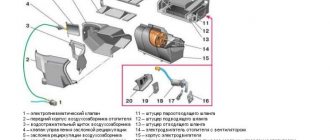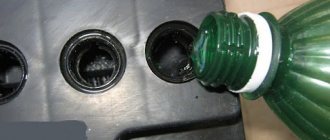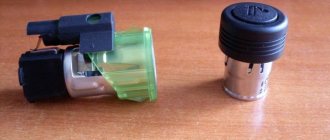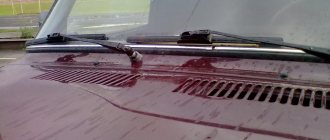Draining coolant from the Lada Kalina system
Before you begin this procedure, you must place the machine on a flat surface, or on a slight slope, provided that the front is slightly higher than the rear. It is also worth keeping in mind that the engine must be cold, otherwise you may get burned during draining.
First of all, we unscrew the bolts securing the ignition module (using the example of engine 21114), since the drain plug is located under it and during draining, antifreeze can get on the coil, which can lead to its failure. There are three of them in total, one is located on the right side, closer to the gearbox, unscrewing it is not very convenient, I had to use a ratchet wrench:
The second one is in the center:
And the last one is at the very bottom on the left side, that bolt can be slightly loosened, you don’t need to unscrew it completely:
Now we carefully lift the module together with the body through the left side and you can put it in such a way that it does not get in the way:
Now you can unscrew the drain plug on the Kalina engine block, after first replacing the container. I did this: I cut off the neck of the one and a half bottle and placed the bottle under the hole:
Of course, such a small container will not be enough, but after filling, I plugged the hole with my finger and inserted a new bottle:
After all the antifreeze or antifreeze has drained from the engine, unscrew the cap in the radiator, which is located in the lower right corner in the direction of travel of the car. First we substitute the container with old antifreeze:
After all the antifreeze or antifreeze has been drained from the Kalina cooling system, we wipe off all traces of coolant on the engine and crankcase protection and screw all the plugs into place.
Some useful tips
Any car owner who has to carry out work to replace or repair a heating system radiator wonders about the reason for the failure of the unit
It is important to consider 2 factors that allow you to extend the continuous operation of the device
- It is necessary to timely replace the system air filter. A clogged radiator is more likely to fail. There is a set period for periodic replacement, but you can do it more often, for example, change the filter after winter use and at the end of the summer season.
- Replace the coolant in a timely manner. This operation should be carried out every 60 thousand kilometers. Accumulating wear products destroy the light metal of the radiator, depriving it of its tightness. Many car owners believe that by periodically adding antifreeze to the system, they will not have to change the unit. However, corrosion products continue to accumulate, having a detrimental effect not only on the heater radiator, but also on the engine as a whole.
A pressing issue is the use of high-quality antifreeze. You should buy it from trusted sellers and do not use water in the cooling system.
The operation of any vehicle involves not only the maintenance and repair of parts and systems that ensure its movement. Assistive devices play an important role in the operation of a car. And if the radiator of the cooling system fails, not only the microclimate in the car is disrupted, but it also becomes unsafe to drive due to fogging of the windows.
| Many car enthusiasts note that the Kalina’s heater is much warmer than that of other VAZ cars, but problems occur here too. In this article, we will consider in order why the stove on Kalina does not work. |
How to get rid of fogged windows
In winter, car windows sweat a lot, especially in severe frost and at night. Modern cars, unlike earlier “classics,” are less susceptible to fogging. In addition, many models have a heated windshield function. But if there is no heating, and the stove is faulty or there is poor air access into it due to a clogged filter, then condensation will quickly form in the cabin.
What to do in this case? Check the antifreeze level in the cooling system to see if the cabin filter is clogged with dust and the radiator is not clogged with debris. A not fully open radiator tap is also the cause of poor interior heating. There was an article in more detail about the poor operation of the stove.
The main thing that causes your car glass to freeze in winter is a malfunctioning thermostat. A stuck thermostat in the open position will not allow the engine to heat up to the required temperature. Due to the low temperature, the windshield and side windows will constantly freeze. And the higher the speed and the stronger the frost, the worse the situation.
Insufficient engine heating due to a faulty thermostat, the cause of foggy windows
Wet weather and rain
In spring and autumn, of course, it is warmer, but still, due to the temperature difference and high humidity, condensation forms quickly. Here, to make the windows sweat less, try to keep the interior dry, especially the floor mats.
These recommendations are suitable for rainy weather. But it is enough to turn on the glass blower or turn on the heater and the problem is solved. A slightly open window can solve the problem; of course, in winter this is not an option.
Excessive fogging is caused by car washing. Here you need to dry the interior. To do this, turn on the interior heating or open the windows slightly. Both climate control and air conditioning can cope with this by setting the necessary parameters.
System malfunctions
They have all already been named; these are poor performance of the interior and glass heating, as well as a malfunction of the thermostat. It is necessary to take care in advance about their serviceability.
Additional heating
If the system is working properly, but the windows are still fogged up, then you can use an additional heater. It is installed on a torpedo, the directed air flow to the required area evaporates moisture.
Fan heater Koto EFB‑220
Their effectiveness is not high, but installed closer to the glass they can clean the foggy area. However, keep in mind that some have a short operating time and also create a significant load on the on-board network.
A simple look at the problem.
The expansion tank plays an important role in the cooling system. Its main function is to dampen pressure fluctuations in pipelines that arise as a result of an increase (decrease) in the volume of antifreeze during heating (cooling). Thanks to the presence of such a container, mechanical loads on system elements are reduced, water hammer and the appearance of air locks are prevented.
In fact, the tank replenishes the lack of fluid in the lines during cooling and serves to receive excess fluid when heating. Structurally, it is made in the form of a plastic sealed container.
A mandatory part of the design is a safety valve for releasing excess pressure into the atmosphere.
When antifreeze heats up, it expands, filling the free space of the tank, and the evaporation rate increases. This leads to an increase in pressure in the volume. An increase in pressure above a threshold value triggers the built-in valve.
The only situation when antifreeze is thrown out of the expansion tank is when the valve fails to perform its assigned functions.
Diagnostics of the stove operation
The operation of the heating system should be periodically monitored. Such a check can be carried out as follows.
- With the engine running, check the operation of the stove without heating the air in all fan speed modes.
- We control the change in the direction of air flow when adjusting the direction switch.
- When the engine reaches operating temperature, check the degree of heating of the air entering the cabin by moving the regulator to the red zone.
- We check the operation of the heating system dampers by periodically moving the regulator from the red zone to the blue sector. The degree of air heating should change.
The owner of the car may not immediately understand that the stove is leaking. The carpets in the cabin are not necessarily wet and a persistent smell of antifreeze does not always appear. This is explained by the possible rapid evaporation of the leaking liquid. The stove in the Lada Kalina does not have pipes leading into the cabin that could wear out.
Duct system
There are also cheap folk ways to combat “fog” on glass. Ten parts of alcohol are added to one part of glycerin and applied to the glass. The old-fashioned method has a significant disadvantage. This composition leaves a greasy layer on the surface. At night, streaks greatly impair visibility and glare appears.
Some even wipe glass with tobacco.
There is also a special film that is glued on, just like when tinting a car. It is similar to the films that are used to cover the visors of motorcycle or racing helmets. But it is advisable to install it in a specialized service, otherwise bubbles will appear under the film, and the result will not please you.
In rainy autumn or winter, water or snow may enter the interior. During heating, the water evaporates and condenses on the glass. Therefore, removing moisture from the interior is very important. Shake off the snow from your feet before getting into the cabin. Clean the interior mats regularly.
Selection of spare parts
The choice of a stove radiator should be approached carefully, since changing it is quite inconvenient. The majority of motorists choose an original part that is available for sale. But few people know that there are several analogues.
Let's consider the heater radiator options for Kalina, their catalog numbers:
- 1118-8101060 is the article number of the original catalog number of the heater radiator for Kalina.
It fits perfectly and does not require any modifications. The average cost in the Russian Federation is 1500-1700 rubles. Original heater radiator and hoses - There are several analogues that are in no way inferior to the original in terms of quality. Thus, spare parts from the following manufacturers are suitable for Kalina: Pekar (1118-8101060), Fenox (RO0001O7), Luzar (LRH 0118). The average cost of an analogue is 1200-1500 rubles.
Kraft stove radiator
Reasons for failure
There are not many reasons for the failure of a stove radiator, but you need to know them. Let's consider the main ones:
- A clogged radiator, which led to pressure, resulting in a breakdown of the internal tube.
Antifreeze flows into the cabin due to a breakdown in the heater radiator - An air lock can also cause a radiator leak.
- Wear. Frequent use of the stove leads to wear on the inner walls of the tubes.
We recommend: Reasons for the decline in engine dynamics
Perhaps these are the main reasons, but others may arise due to the operation of the car.
Technical device of the heating system
The functions of the heating system are to heat and cool the vehicle interior, as well as to blow warm and cold air onto the windows. If you cannot effectively warm up the interior, and the windows constantly fog up, you should look for the reason in the operation of the stove.
Lada Kalina has a traditional supply and exhaust system, and the air is heated by liquid heated to 90°C in the cooling system, which is then pumped through the stove. In the stove, heat exchanges water with air, which is subsequently directed through air ducts into the cabin.
Heating system in the car
The heating system of the Lada Kalina includes the following elements.
- Radiator with air distributor.
- Electric fan.
- Ventilation system filter.
- Air ducts.
The fan on Kalina has 4 operating modes. The change in rotation speed is ensured by the operation of additional resistances. If it is necessary to replace resistors, it should be taken into account that they have a resistance of 0.23 and 082 Ohms.
The air flow is carried out through an intake device installed in front of the windshield. Before entering the cabin, the air is cleaned through a cabin filter. The filter element is made of synthetic fabric, and its replacement is necessary every 15 thousand km.
Why do windows sweat?
Let's figure it out. There are only three main reasons:
- Large amount of moisture
- Poor ventilation
- Malfunction of the heating (air conditioning) system
I recently had such a case - a cheerful group was sitting in a car, it’s cold outside now, but it’s just right there. They drank alcoholic drinks and there were 4 of them there, the stove was working and it couldn’t cope! And they were surprised - why do the windows fog up because the car is almost new? There are several reasons - it’s cold outside, there are a lot of people, beer was spilled on the rugs (that is, moisture), and alcohol, which quickly settles on the glass.
So if you drink in the car , then you shouldn’t be surprised. BUT this is a lyrical digression; now I will look into serious issues.
Troubleshooting methods
Auto repair technicians can quickly and accurately determine where the coolant goes. But sometimes the car owner simply has nowhere to go and needs to fix the breakdown on his own. In some cases this is possible:
- The pipes need replacing. If the breakdown makes itself felt on the road, the liquid can leave the system very quickly, so you can temporarily fix the crack with adhesive tape or tape.
- A crack in the expansion tank can be sealed. But this is another temporary measure that will prevent antifreeze from running at high speed.
- A stuck lid valve can be cleaned, this will help return the proper fluid level to the system. If cleaning does not produce results, then it is worth replacing the part with a new one.
Problems with the pump and radiator are very difficult to fix on your own. In rare cases, repair of important elements of the system is possible, but most often it is necessary to replace parts.
Have you encountered such an incomprehensible phenomenon, where does antifreeze go if it doesn’t leak anywhere, because if so, then our post today will be devoted to this topic
And it doesn’t matter what kind of car you have, Hyundai Santa Fe or another, they all use a liquid called antifreeze in the winter season
alcohol
The windows may fog up if there is a passenger in the cabin who drank alcohol the day before or just drank a cup of hot tea or coffee. The windows may fog up if there is a passenger in the cabin who drank alcohol the day before or just drank a cup of hot tea or coffee.
How to fight?
The easiest way to combat fogging is to make the air dry. To do this, turn on the air conditioner. It dries the air very quickly. You can also change the air circulation in the cabin by directing the ventilation deflectors at the windows, thereby heating the latter. Monitor the condition of the cabin filter. If it is clogged or wet, it must be replaced, otherwise the glass will sweat regularly.
What the driver should do to prevent the windows from sweating: ways to fix the problem
So, having figured out the reasons why car windows often sweat, you can move on to what to do in such a situation. Of course, the easiest way is to buy a rag and constantly wipe the glass before driving.
You can also constantly turn on the stove, drying the interior. The downside is the long wait for the engine to warm up during a cold start and for the windows to fog up. True, you can constantly turn on the air conditioner (if available), which quickly “dries” the air and removes moisture, but fuel consumption increases, the life of the air conditioning system decreases, etc.
Moreover, this approach of removing moisture with a rag or using air conditioner does not solve the problem itself, but only allows you to get rid of the consequences. If you need a more effective solution, below we will look at ways to avoid fogging.
The presence of glass that is less prone to fogging, as well as their heating, allows you to quickly dry the windows in your car without turning on the heater or air conditioner. Also in winter, heating the windows allows you to quickly clear the outside of the windows from ice and snow. It turns out that if the problem of glass fogging is acute for the driver, this feature must be taken into account at the stage of selecting a car.
- Let's move on. To reduce glass fogging, you also need to periodically service the heating and ventilation system of the car interior, check the operation of the stove, fan, etc. As mentioned above, you need to promptly change the cabin filter and turn off recirculation.
You can also stick a special film on the glass that resembles tinting. This film also has the property of preventing the accumulation of moisture on car windows. In addition, there is another solution - a defogging agent for car windows.
If desired, you can make your own anti-fog at home by mixing denatured or ethyl alcohol with glycerin. The proportions are 20:1, where 1 is glycerin. Then it is better to place the mixture in a spray bottle for ease of application.
How to replace a radiator: basic methods
As we mentioned above, replacing the radiator on Lada Kalina cars is a rather complicated procedure that requires disassembling the entire front panel. To do it yourself, you will need to prepare tools - pliers, a Phillips screwdriver, a wrench, as well as knowledge of the sequence of work described below:
- drain the coolant and first unscrew the screws holding the radiator, and then the nuts that secure the gas pedal;
- remove the electronic engine control unit;
- unscrew all the screws holding the torpedo. It is best to do this using the instructions for the Lada Kalina car in order to avoid completely unnecessary mistakes;
- remove the panel. Here we will make a small digression and give a useful recommendation. It is better to carefully put all the fasteners that hold the torpedo in one place, remembering their location in the car’s structure. Otherwise, you will simply get confused, because there are quite a lot of screws, bolts and self-tapping screws in the Kalina model;
- remove the seal frame, which allows you to get to the radiator and remove the broken part;
- We install the new device and assemble the front panel in the reverse order. Make sure that there are no “extra” parts or fasteners left.
We recommend: Replacing pads on a VAZ 2107
How can I check the operation of the heater damper?
- Set the temperature control knob on Kalina to the extreme position of the blue sector, and the fan speed to the maximum value.
- Turn the damper control handle on the block and at the same time watch for changes in the direction of the air flow.
If the air flow remains unchanged, this indicates a breakdown of the mechanical control unit of the stove. Most likely, the rod fell off and stopped screwing onto the roller due to its malfunction. Or the second option could be that the damper is stuck. If your car has climate control, then check the damper micromotor and check the condition of the ventilation control unit, heater and air conditioner.
Diagnostics of the stove operation
The operation of the heating system should be periodically monitored. Such a check can be carried out as follows.
- With the engine running, check the operation of the stove without heating the air in all fan speed modes.
- We control the change in the direction of air flow when adjusting the direction switch.
- When the engine reaches operating temperature, check the degree of heating of the air entering the cabin by moving the regulator to the red zone.
- We check the operation of the heating system dampers by periodically moving the regulator from the red zone to the blue sector. The degree of air heating should change.
The owner of the car may not immediately understand that the stove is leaking. The carpets in the cabin are not necessarily wet and a persistent smell of antifreeze does not always appear. This is explained by the possible rapid evaporation of the leaking liquid. The stove in the Lada Kalina does not have pipes leading into the cabin that could wear out.
Folk remedies
If it is not possible to purchase special equipment at a car store, then you can use folk remedies, although less effective, but cheap. Here are a few ways to prevent fogging:
- Shaving foam or gel. Apply a thin layer and rub over the glass.
- Soap. Apply a fine mesh onto the glass and rub with a rag.
- Salt. At the very least, poured into bags helps. If you rub it, it dissolves ice on glass well.
It is clear that foggy windows in a car are a common occurrence caused by the difference in temperature between the interior and outside air, as well as increased humidity in the cabin. During normal operation of the heating or ventilation system, fogging is eliminated fairly quickly. In winter, you need to warm up your car.
Why do car windows sweat from the inside when it rains?
foggy rear window in a car during rain To answer the question, let’s remember physics from the school curriculum.
- Air consists not only of oxygen molecules, but also water. The latter tends to accumulate/decrease depending on temperature and contact with objects/objects.
- So there is more water vapor in warm air than in cold air. But when interacting with cooler objects, such as glass, you see condensation.
- It turns out that when it rains, the temperature outside the car’s interior drops, but inside it remains unchanged.
- Windows, located on the border of two spaces, also become colder. Therefore, the warm air in the cabin, colliding with them, condenses on their surfaces.
Causes of window fogging
The reason for this very unpleasant phenomenon is the physical process of moisture condensation on a colder surface. Water vapor in the air is deposited on parts in the form of droplets. For a car, this may be relevant in several cases:
- in the cool season: spring, winter, autumn;
- in the rain. Wet clothes, rugs, and covers increase condensation many times over;
- when washing a car;
- tipsy passenger (transitory effect). Alcohol vapor absorbs moisture and condenses on the windows;
- poor stove performance. This means a faulty tap, clogged stove channels or insufficient antifreeze level;
- thermostat malfunction;
- antifreeze leak. If the heater radiator is faulty, antifreeze mixes with air and is deposited on the windshield in the form of a thin oily film that never disappears.
There is nothing surprising here, and no matter how hard you try, you will never be able to prevent the windows in your car from sweating. But this effect can be minimized and some practical advice will be considered.
You need to understand that the higher the temperature in the cooling system, and the interior heating system is working properly, all the causes of condensation formation are minimized.
All the reasons why the car windows sweat inside the cabin are related to elimination methods.
Possible heater malfunctions and ways to eliminate them
If the stove blows very weakly or in the current mode it basically refuses to blow air, then there may be several malfunctions, as well as solutions:
- The heating system hoses are worn out. As a rule, if antifreeze leaks or the stove does not heat, this may be due to wear and tear on the pipes. To solve this problem, it is necessary to carry out a thorough diagnosis of each of the pipes. Coolant may escape through cracks or other damage.
- The heater valve has failed. If the stove control valve is broken, this can be indicated by traces of leakage of consumables in the vehicle interior.
- There are malfunctions in the operation of the control unit. If the problem lies in the unit, then first of all you need to check the quality of its connection to the on-board network. If it is connected correctly, then most likely the problem lies there. It is better to entrust unit repair to specialists.
- Wiring faults. Perhaps the unit does not turn on the heating system due to lack of contact with the on-board network. In this case, the problem is solved by checking the circuit to find the broken section.
- The additional resistor is broken. This device is used to control the heater fan, so if the stove on Kalina does not heat, you also need to check the functionality of this element. If it doesn't work, then it will need to be changed.
- The Kalina heater regulator, located in the car's interior, does not work. If the heater only blows hot air, but does not react in any way when switching its mode from hot air to cold air, then most likely the regulator installed on the center console has failed.
- The radiator of the heating unit is broken. This problem is considered one of the most common on domestic cars, and it is especially relevant for Kalina. You can try to repair this device or change it yourself. We will tell you more about how to shoot and how to replace the device below (author - Interesting Video channel).
Why does antifreeze leak?
The engine cooling system consists of several main elements, as well as connecting pipes. Antifreeze in the system is a mixture of water and concentrate in certain proportions. As the internal combustion engine heats up, the temperature of the coolant also increases; the coolant itself is in the system under a certain pressure. It is quite obvious that any defects in individual components associated with tightness will cause leaks. Problems can arise both with the elements themselves and with the pipes. Let us add that in some cases the driver may encounter the fact that antifreeze leaks when cold, leaks appear after the internal combustion engine warms up, the leak can be intense or unnoticeable (antifreeze leaves slowly or quickly), etc.
The windows in the car fog up: the main reasons
So, if the car windows sweat, it often happens in winter, during rain or fog, that is, in conditions of high humidity. Naturally, visibility in such conditions is usually poor, and if you add to this that the windshield, rear and side windows sweat, the risk of an accident increases significantly.
It also happens that the cause of foggy windows is not only the weather. In any case, you need to know what to do in such a situation and what measures to take to prevent the car windows from sweating. Let's look at the causes and ways to fix the problem.
- Let's start with the simplest one. First of all, in winter, windows sweat because condensation forms as a result of the interaction of warm air inside the cabin and cold air outside. This condensation settles on the glass, causing the car windows to fog up.
- Now let's move on to the less obvious reasons why car windows sweat. For example, if there are passengers in the car who have recently consumed alcohol, then this is the reason why the car windows are sweating.
In fact, alcohol vapors exhaled by a person who drinks alcohol have the ability to absorb moisture, which causes it to settle on the car windows and fog up the car windows.
Also, problems in the interior ventilation system lead to fogging of the glass in a car. Often, we are talking about the interior air filter. Its contamination, defects, model mismatch or errors when installing the cabin filter cause the filter to not absorb moisture and dust properly. The result is foggy windows.
In fact, the damper blocks the flow of outside fresh air, and the air from the cabin circulates in a circle. In certain situations, this function is useful, as it allows you to avoid the entry of dust and unpleasant odors from the outside, the interior can be warmed up or cooled down faster by turning on recirculation, etc.
However, interior air recirculation should not be switched on all the time. If you close the flow of fresh air for a long time (20-40 minutes) or more, the windows will begin to actively sweat, and the driver and passengers may also feel drowsiness, deterioration, etc. The reason is a lack of oxygen, a noticeable increase in air humidity inside the cabin, etc.
If air recirculation is turned off, and the windows still sweat for no apparent reason, the valve through which fresh outside air enters the cabin may break. The sensor that controls the damper may also fail.
Replacing the radiator without removing the front panel
The classic method of replacing a Kalina heater radiator, a video of which we presented on the page, involves complete dismantling of the interior. It’s doubly disappointing that you have to lose a whole day if you change the radiator yourself, or five thousand and also a whole day if you use the services of a service station.
However, there is a method that allows you to replace the radiator with less labor and faster. An alternative replacement method is to use a hacksaw saw to cut out a segment with pipes from it before removing the old radiator, or simply cut off the pipes. If the radiator is aluminum, then in this case the pipes will be plastic and removing them will take at most 15 minutes. There are some other nuances to consider when replacing.
After removing the pipes, so as not to weaken the front panel, you can also make cuts in the places shown in the photo on the heater casing. In this case, you no longer have to completely dismantle the panel when replacing the radiator. Simply drain the antifreeze, remove the gas pedal (you can also remove the brake pedal mounting block, although many do without it), shorten the standard guide pin by 10 mm (with large wire cutters, pliers), remove the old radiator and put the new one in place.
This way you can simply solve the issue of replacing the heater radiator on Kalina, saving time and money. Use the right antifreeze and have a good winter road trip everyone!
We recommend: Troubleshooting the fuel gauge
Problems with Kalina's heater elements?
To understand why Kalina’s stove does not work, you should understand its operating principle: The heater control unit (HCU) receives a signal from the ceiling temperature sensor in the cabin (installed in the interior lamp) and compares it with the temperature set by the driver. If the difference is greater than a certain value (for example, more than 2 degrees), then the ACS unit sends a control signal to the micromotor-gearbox (MMR), which controls the heater dampers (opens or closes hot air from the heater).
Therefore, if Kalina’s stove only blows hot or cold air, regardless of the position of the handle on the heater block, then start by checking the interior temperature sensor.
Another reason for the heater not working properly could be the Kalina heater control unit itself (for example, there are problems with the heater damper), but don’t rush to buy a replacement without making sure the actions are correct. The easiest way to find out why the stove is not working properly is to replace the part with a working one and check its functionality. It is not necessary to buy a new part; you can ask a friend for a known working part, or negotiate with the seller, leaving a deposit. Thus, we have considered all the elements of the heater (see also the design of the Kalina stove). Start following the order of the article, moving from simple to complex, and then you will certainly be able to repair Kalina’s stove with your own hands!
Many car enthusiasts ask a well-founded question, what to do if the Lada Kalina stove does not work? The answer to this question lies in a thorough diagnosis, the result of which is an accurate determination of the causes of the malfunction.
Troubleshooting
We will analyze the hidden defect when it is necessary to change the engine gasket. You cannot delay this, despite the apparent complexity of the process - almost anyone can repeat it.
We purchase a gasket for your engine, make no mistake, this is important! It is advisable to select by VIN CODE Why do we remove the cylinder head cover, usually from 8 to 12 bolts. Most likely, you will need to remove all sorts of pipes and other “air filters” attached to the top above it so that they do not interfere. Afterwards we need to unscrew the block head itself, here you will need to try, as a rule, they tighten the bolts tightly, if one of them unscrews easily - then most likely it’s the problem, it was simply not tightened at the factory! It is quite possible that after stretching the antifreeze will stop leaving the system! So first try tightening all the bolts. If it doesn't help, remove the head
As a rule, the leak will be immediately visible, it is either a crack or drips. I would also like to note that the gasket is disposable; you cannot do it by unscrewing the head once, for various reasons, and then putting it on the old gasket. The whole point is that it wears out - so you only need to install a new one.
After replacement, put everything back together in reverse order.
It is necessary to pay special attention to the tightening of the cylinder head; it is done in a checkerboard pattern, with a certain force, which is adjusted with a torque wrench
Personally, I myself have fixed this breakdown a couple of times on our VAZs and GAZELLES. Antifreeze or antifreeze will stop leaving.
Why do windows sweat from the inside on a Kalina station wagon?
Recently I wrote in one of my posts about how the first Granta appeared in the city. So, when I drove it, I noticed that the windows were fogged up and nothing was helping, although the heater was on and the fan was running at almost maximum power.
And my friend also says that the windows are sweating, he can’t do anything. Of course, I knew the reason for the fogging of the windows, but I didn’t think that it was so difficult to guess, because he had already driven about 1,500 km, and the windows were constantly fogged up.
Of course, I, too, when I bought my Kalina, drove several kilometers and noticed that the windows were sweating, but I immediately discovered the reason. Everything was quite simple, the culprit was the damper, which blocks the flow of fresh air into the cabin, and accordingly, because of this, the windows sweat. But of course there is a benefit from this damper, and a very big one.
This damper is very useful, for example, when you drive past large industrial facilities that emit a not very pleasant smell, on my route there are mainly pig farms and poultry farms, the stench is terrible, but you close the damper and everything is fine, there is no smell in the Kalina’s cabin .
This damper also helps a lot in winter, when you need to quickly warm up the car interior; when you close the damper, fresh air does not enter the cabin, and internal air circulates in the cabin. And the plus is that when the damper on Kalina’s stove is closed, the air flow is much stronger than when the damper is open. Accordingly, the car interior will warm up much faster than with the air damper open.
Another reason for the windows fogging up in the cabin may be that the cabin filter is clogged.
I wish you good health, dear friends! We say winter has come, winter has come. I don't feel something. Since January 10, our temperature has remained at -5 - +2. The asphalt is already gone on the road. In the yard where we clear the snow, dirt has already begun to appear... Phew! Let it be summer soon) So, now on to the topic. Occasionally, posts about fogging of rear windows on domestic “foreign cars” began to appear on the drive feed. Knowledgeable and experienced people have found a way out, it turns out that the smart guys from the AvtoVAZ plant have closed the ventilation hole in the trunk with a piece of vibration insulation. I don’t know why they did this, but it needs to be removed urgently! That's what I thought. Maybe it’s not just me... And I got down to business. It ends up in a cold garage, or in winter it’s difficult to get it off. But with a knife it worked...
I forgot to tell you how and where this hole is...
Important! After the work done, i.e. When you have removed this sheet of Shumka, you need to stick it or glue it onto the hole with a frnk or some other filter material. In theory, there should be flaps in the bumper, but half of them are not installed... Therefore, dust will enter through this hole. And you have to vacuum and wash everything twice
Kalina heater diagram
The Lada Kalina heater device is designed for heating and cooling the car interior. If the car does not heat up, the windows fog up, or you feel discomfort, then you need to test the performance of the heating system. Understand the functioning of the stove on Kalina.
General layout of the Kalina stove
The location of the stove was designed for easy installation of an air conditioner. The system is simple, but at the same time quite reliable.
- Left side flow outlet.
- Left air duct.
- Heated side window.
- Air flow splitter.
- Stove.
- Right ventilation duct.
- Right side flow exit.
- Bottom heating duct.
- Interior heating duct.
- Central outlet of ventilation flows.
The supply and exhaust principle is used. The air masses inside the car are heated using a special liquid, which simultaneously cools the engine. The operating principle of the Kalina stove is based on the fact that the liquid warms up the radiator, where heat exchange occurs, and the heated air passes into the cabin through the air ducts.
If we analyze Kalina’s heater, the operating principle and the heater circuit will differ in configuration. The first option has a simple and reliable design. And in the other - full electronic control. The air passes through the filter into the air intake, and then the fan blows further through the system. The engine is running and warmed up. Antifreeze moves through the system in which the heater radiator is involved.
The amount of air that is heated by the stove radiator is regulated by a damper. Controls the operation of the fan and dampers by a unit located on the central panel.
Heating device control unit
- Temperature regulator. We change the heating of the air flow by turning the knob. The blue zone produces cold air, the red zone produces warm air.
- Fan speed switch. By turning the knob clockwise, the intensity of the air flow is adjusted. Choose one of 4 fan speeds.
- Air flow separation selector. Distributed in specific areas:
The flows pass through the upper part of the cabin.
The air is directed downwards.
Air flows are directed onto the windshield and down.
How to remove the electric motor of the VAZ 2108, 2109, 21099 stove
Air flows are concentrated in the area of the windshield, as well as the side ones.
- The handle that controls the recirculation of cabin air. We turn on the mode when driving off-road or in a traffic jam. Used for a short time, the glass fogs up.
- Rear window heating mode switch.
We regulate the direction and saturation of air flows through aerodynamic devices. We turn the guide blades and change the position of the dampers to achieve the desired air direction.
Interior ventilation of Lada Kalina
The outlet pipes are located in the car body under the trunk. The heater is located under the dashboard. The air flow enters the car interior through an intake, which is designed in front of the windshield in the engine compartment. The air enters through the filter and is accelerated throughout the cabin under pressure created by the fan.
1.Pipes for supplying air to the rear of the cabin.
2.Side ventilation nozzles.
3.Blowing the side windows.
- Windshield blower nozzle.
5-6-7. Central deflectors for flows entering the car interior.
We direct the supply air through the deflectors by turning the handwheel. If we turn it up, the flap opens and vice versa. You already understand how the stove on Kalina works.
What to do, manufacturer's recommendations
How to get rid of fogged windows is indicated in the car's owner's manual. Below are excerpts from the Lada Vesta manual.
The heater/air conditioning fan should always be on when the vehicle is moving.
, at least to 2nd speed, to create excess pressure in the cabin in order to prevent dust and dirt from entering through leaks in the body, as well as to avoid fogging of the windows.
To eliminate fogging of the windows, for example in damp weather, it is necessary to direct warm air onto the windows
car. Press the button (windshield defrost) or (windshield and foot defrost). Set the air flow speed to medium or maximum to effectively blow the car windows.
Set the maximum supply air temperature
, if necessary, adjust the air temperature. The air supplied to the windows must be warmer than the outside air.
Turn on the supply of fresh air ( off
recirculation
).
Use the “Defrost MAX” mode.
The “Defrost MAX” mode provides the most effective cleaning of the windshield, rear window, front side windows and outside rear view mirrors from fogging, frost or ice.
Don't forget to use electric heaters
(windshield and rear window).
Have you ever experienced fogging of the windows in your car? How did you solve the problem?











